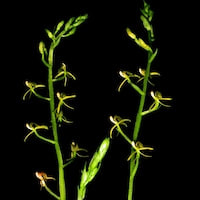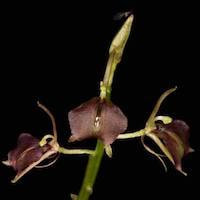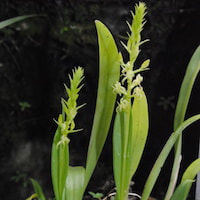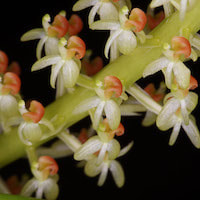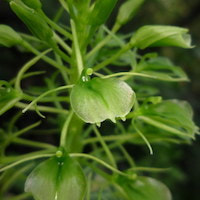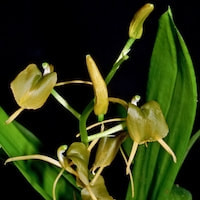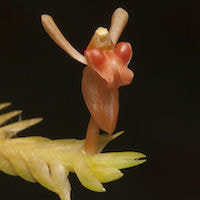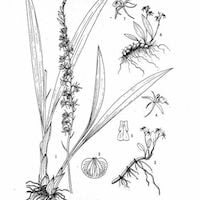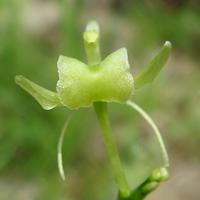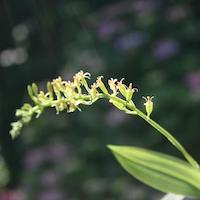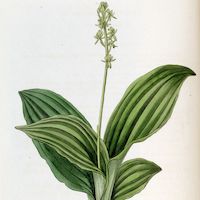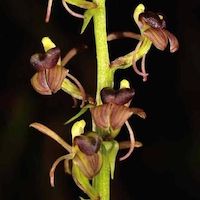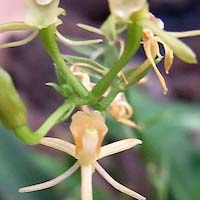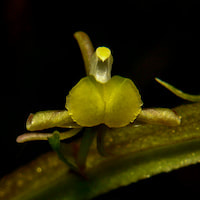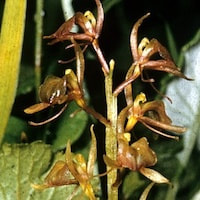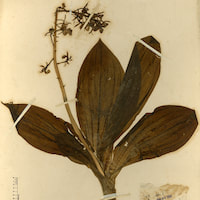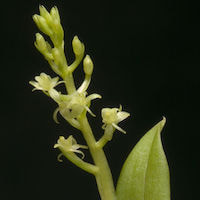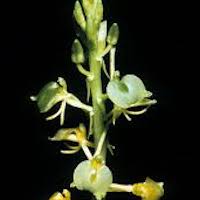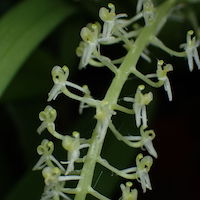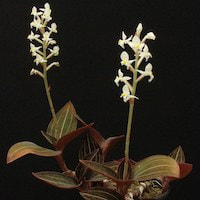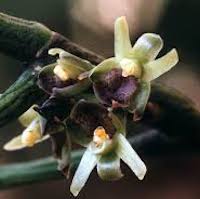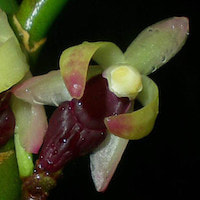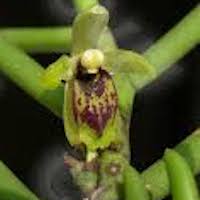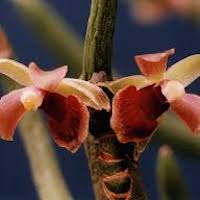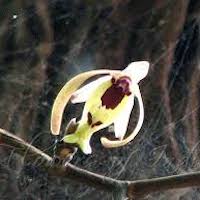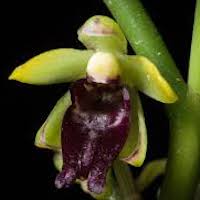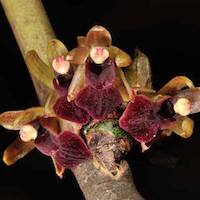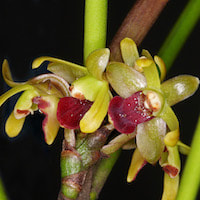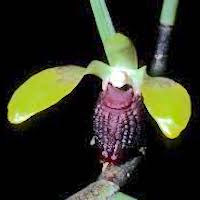|
Liparis bootanensis Griff. Syn. Liparis plicata Franch & Savat.
Chinese name: Lianchiyangersuan (sickle wing goat ear garlic). In Hong Kong and Bhutan Twayblade Chinese medicinal name: Jiuliandeng (nine lotus lamps) Taiwanese name: single leaf Liparis Japanese name: Chi-kei-ran (bamboo grass Cymbidium) Herb is epiphytic or lithophytic, with small, clustered, ovoid pseudobulbs. It is distributed from Nepal to south- ern China up to Hainan, Hong Kong, Taiwan, Japan (Ryukyu Islands, Kyushu), Korea, Indochina, Thailand, Philippines, Borneo, Java, the Langkawi Islands and Myanmar at 800–2300 m. Herbal Usage: Botanically, in CTM, Jiuliandeng, the entire plant is used to treat fever, enrich qi and blood, treat tuberculosis, lymph node enlargement in tuberculosis, sores and ulcers, abdominal pain, distension and schistosomiasis. Cooked with pork, it provides a remedy for coughs and sore throat. |
|
Liparis cathcartii Hook.f.
Chinese name: Erzheyangersuan (two fold sheep ear garlic It is a small terrestrial herb. It is distributed only in Sichuan and central and northwest Yunnan in China, but it also occurs in Laos, Myanmar, northeast India, Bhutan and Nepal. Herbal Usage: Chinese herbal medicine employs the whole plant to stop pain and to clear colds. |
|
Liparis cespitosa (Lam.) Lindl.
Chinese name: Xiaohuayanger Suan (small flowered goat ear garlic), Shisuantou (stone garlic), Yeshengyangersuan (goat ear garlic), Congshen-gyangersuan It flowers in September, January and March in Sri Lanka. The species enjoys a wide distribution from East Africa across the Himalayan foothills, southern China and Southeast Asia to the Pacific Islands. Herbal Usage: The whole plant is used in Taiwan to treat fever and remove toxins. In CTM terminology, it cools blood and stops bleeding. |
|
Liparis condylobulbon Rchb. f. Syn. Liparis treubii J.J. Smith
Indonesian name: Anggrek gajang It is distributed from Myanmar, Thailand to Malaysia, Indonesia, the Philippines eastwards to Fiji. Herbal Usage: Natives in Sulawesi (Indonesia) once believed that chewing on the young pseudobulbs and rubbing the heated leaves of the orchid on the abdomen facilitated bowel movements and relieved a distended stomach. |
|
Liparis cordifolia Hook. f. Syn. Liparis argentopunctata Aver., Liparis keitaoensis Hayata
Chinese name: Xinyeyangersuan (Silver cricket orchid). Phytochemistry: Two alkaloids, keitaonine and keitine were isolated from L. keitaoensis (¼ L. cordifolia). Keitaonine is a pyrrolizidine- based alkaloid, an ester of 3-methoxy-malaxinic acid and laburnine. Keitine is an aglycone of keitaoine but it is possible that it might not exist in the living plant. Herbal Usage: A decoction of the root is a Taiwanese remedy for abdominal pain |
|
Liparis distans C.B. Clarke Syn. Liparis yunnanensis Rolfe
Chinese names: Yunnan yanger Lan (Yunnan sheep ear orchid), Dahuayan-gersuan (big flower sheep ear garlic) Yunnan Yangercao (Yunnan sheep ear herb) Chinese medicinal name: Hushitou It enjoys a wide distribution from Guangdong, Guangxi, Guizhou, Yunnan, Sichuan and Tibet in China to Assam, Thailand, Laos Cambodia, Vietnam and the Philippines. Herbal Usage: Herb is obtained from Guangdong, Guangxi, Yunnan, Sichuan and Tibet. Entire plant is used to treat pneumonia. A decoction is made with 6–16 g of the whole plant. |
|
Liparis dunnii Rolfe
Chinese names: Dachunyangersuan (big lip sheep ear garlic), Fujianyangersuan (Fujian Province goat ear garlic) Chinese medicinal name: Shuangyejinqiang This narrowly-endemic species was originally discovered during a botanical expedition in cenral Fujian province in 1903 growing on rocks at Tze Chuk Hang. |
|
Liparis fargesii Finet
Chinese name: Xiaoyangersuan (small lip sheep ear garlic) Chinese medicinal name: Shimi It is found at 300–1700 m in Southern Gansu, Guizhou, Hubei, Hunan, Shaanxi, Sichuan and Yunnan. The plant is cold-resistant. Herbal Usage: Herb is obtained from Shanxi, Sichuan and Gansu. Entire plant is used in Chi- nese herbal medicine. It benefits the lungs, reduces heat, stops coughs, and is prescribed for tuberculosis, heat coughs and whooping cough. To prepare a decoction, 6–9 g of the dried herb is used at a time. |
|
Liparis kumokiri F. Maek.
Chinese name: Xuesancao (spread snow grass) Japanese name: Kumokiri so The medicinal herb comes from Shanxi It is common terrestrial herb in the Russian Far East, Korea and in Japan between Hokkaido and Kyushu. Herbal Usage: Roots and stem are used to strengthen the constitution, improve blood and air flow. It stops persistent intermenstrual bleeding and cures discharge. |
|
Liparis nervosa (Thunb.) Lindl. Syn. Liparis bicallosa (D. Don) Schltr.
Chinese names: Honghuayanger Suan (red flowered goat eating garlic), Hei Lan (black orchid), Shixiagong (stone shrimp), Banbian Lan (half sided orchid) Roupangxie (crab meat); Lidihao (well grounded); Maocigu (hairy kind aunt); Yanyu (stone yam); Tiepashu (Steel rake); Daoyanti (dangling on the cliff); Zuozicao (moving seed herb); Roulongjian (dragon meat arrow). In Hong Kong: nerved twayblade, purple star Liparis Chinese medicinal name: Jianxueqing Japanese name: Koku ran Description: A small terrestrial herb that flowers in February to July on the Chinese mainland and in June and July in Taiwan. In Sri Lanka, it flowers in February to March, and again in June to September. It is an extremely variable, pan-tropical species which enjoys a wide distribution throughout the humid tropical and sub-tropical regions. Phytochemistry: Nervosin was isolated from this plant. It is an ester of lindelofidine and nervosinic acid, the latter an arabinosyl-glucosyl derivative of nervogenic acid which is a starting point for alkaloids. All alkaloids of L. nervosa inhibited each of the 12 bacterial and 4 fungal species tested with a paper diffusion method. Anti-oxidant effect ranged from 5 to 93.5 % at concentrations of 0.5 to 100 mcg/ml. Recently, 6 new pyrrolizidine alkaloids and two previously identified alkaloids were isolated that showed antioxidant activity on RAW264.7 macrophages. Herbal Usage: The whole plant is used as an antipyretic, to cool blood, stop bleeding and reduce heat in the lungs. It is used for cramps in children, haemetemesis, coughs, and rheumatic pain. It is also used as an emollient for traumatic injuries, skin infection and snake bites. It is reputed to reduce inflammation, dissolve extravasated blood and cause swellings to subside. The herb is collected throughout the year. For decoction, 3–6 g of the fresh herb or 6–12 g of dried herb are used. For external use, the whole plant is pounded and soaked in wine. Tubers are used to treat stomach disorders and a paste is applied on chronic ulcers in Nepal. |
|
Liparis odorata (Willd.) Lindl. Syn. Liparis paradoxa (Lindl.) Rchb.f.
Chinese name: Xianghuayangersuan Chinese medicinal name: Erxiantao It is a terrestrial herb, with herbaceous, conspicuously veined, petiole sheath-like. Inflorescence. In India, it flowers from July to September, in Bhutan, from May to September, in Nepal, July and in China, April to July or August. Herbal Usage: Mr. van Rheede wrote in his Hortus Indicus Malabaricus that this species was used to treat elephantiasis. This plant is used in Malabar to treat elephantiasis. Tribals in Karnataka use the orchid pseudobulb. They also use its juice extracted from the leaves, which is used to treat fever and oedema. Juice from the roots was used to treat burns, inflammation, gangrene and tumours.
|
|
Liparis petiolata (D. Don) P.F. Hunt & Summerh.
Chinese name: Bingyeyangersuan (handle leaf sheep ear garlic) Description: This is a terrestrial herb with ovoid pseudobulbs. The species is found near streams at 1000–2900 m in Hunan, Jiangxi, Guangxi, southern Yunnan and southeast Xizang. It is also found in Vietnam, Thailand, Bhutan, Nepal and northeast India. Herbal Usage: It benefits the lungs |
|
Liparis rheedii Lindl.
Indian Name: Simil It is a terrestrial herb with pseudobulbs close to one another. The colour of the plant and its flowers is dependent on the amount of light that it receives. Plants growing in the shade are deep purple whereas those growing in the light are a pure green. The species occurs in mountain forests from southern India, across Thailand, Indochina, Malaysia and Indonesia to New Guinea. Herbal Usage: It is widely used as a tonic in Karnataka. It is one of the eight ingredients of the Ayurvedic drug known as Ashtavarga. The root is used by the hill tribes in Orissa to treat cholera. About 250 g of root is decocted in a liter of water until the volume is reduced to 333 ml. After cooling, 5 ml of the decoction is mixed with 2 ml of honey and orally administered twice a day on an empty stomach for 15–21 days as a remedy for cholera. |
|
Liparis Rostrata Rchb. f.
Chinese name: Chitu yangersuan Pseudobulbs are small, ovoid and produces a stem from its base. Flowers are tiny with linear yellowish-green sepals, dark purple, filiform petals. It is distributed from northern Pakistan to western Nepal, southern Xizang and at Gaoligongshan in Yunnan, on soil-covered rocks. Usage: Tubers are used to treat stomach disorders in India and it is also used as a tonic. |
|
Liparis sootenzanensis Fukuyama Syn. Liparis nigra Seidenf. var. sootenzanensis Fukuyama
Chinese name: Chatianshanyangersuan; Zhihuayangersuan (purple flower sheep ear garlic). In Hong Kong: giant purple Liparis This robust terrestrial herb is distributed from Yunnan to Guangxi, Guangdong, Hainan, Taiwan, Hong Kong and Lantau Islands. Herbal Usage: The whole herb is used to treat arthritis, numbness and skin disease in Vietnam. |
|
Liparis stricklandiana Rchb. f.
Chinese names: Shanchunyangersuan (fan lip sheep ear garlic), Luhuayangersuan (green flower sheep ear garlic) It is an epiphytic species distributed from Hong Kong, China (Guangdong, Guangxi, Yunnan) and Tibet, Vietnam, Sikkim, Bhutan and Nepal, at in forests on hill slopes. Herbal Usage: Herb is used to treat sores, abscesses and ulcers. |
|
Liparis tschangii Schltr.
Chinese name: Xizang Yangersuan (Tibetan sheep ear garlic), Zhebao Yangersuan It found in Tibet, south-west Sichuan, Yunnan, Laos, Thailand and Vietnam at 1100–1700 m. Herbal Usage: Herb is obtained from Tibet and Yunnan. Stems are used in Chinese herbal medicine to improve blood flow and stop bleeding, especially persistent vaginal bleeding. |
|
Liparis viridiflora (Blume) Lindl.
Chinese names: Luhuayanger Lan (green flower sheep ear orchid), Changjing-yangersuan (long stem sheep ear garlic) Plants are lithophytic and have cylindrical pseudobulbs. It flowers in September to December in China, November in Assam and Sikkim and August to September in the Western Ghats. It is an extremely widespread and widely distributed from Sri Lanka and the tropical Himalayas across southern China and Southeast Asia to the Pacific Islands. Herbal Usage: Stems are used to treat coughs, poisoning, fever and fractures. Roots are used to treat hernia. |
|
Ludisia discolor (Ker.-Gawl.) A. Rich.
Chinese names: Xueye Lan (blood leaf orchid), Yisexueye Lan (special colour blood leaf orchid), Shishangou (lotus on the rock): In Hong Kong: rock silk-worm, twisty-flowered orchid Chinese medicinal names: Shishangou; Xueye Lan; Shichan (rock moth) Zhenjincao (genu- ine golden grass) Thai name: Wan nam thong Malay names: Beledu merah (red velvet plant), Baldu merah (red plant) (only applicable to some varieties) Plant has a creeping rhizome. It flowers in March in Singapore. Herbal Usage: The whole plant is used in TCM and it may be collected throughout the year. It is used fresh and also sun-dried. It is sweet, slightly astringent, and ‘cool’. It nourishes the lungs, regulates body fluids, purifies the blood, and is anti- inflammatory. In Hong Kong, it is used to treat hemoptysis caused by pulmonary tuberculosis, neurasthenia, anorexia, employing 3–10 g in decoction. It relieves coughs. On the Chinese mainland, entire plant is used in TCM to enrich yin as it benefits the lungs, cools the blood and stops bleeding. It is used to treat pulmonary tuberculosis, anorexia and neurosis. Rhizomes are listed as 1 of 57 herbal remedies for insect bites in old Thai remedies. |
|
Luisia brachystachys (Lindl.) Bl. Syn. Luisia indivisa King & Pantl.
Chinese name: Xiaohuachaizigu It is a tough, robust epiphyte with terete stems and leaves. It is distributed in southern Yunnan, Thailand, Bhutan, India, Myanmar and Vietnam, occurring at 600–1300 m. It is fragrant and 2 important chemicals were found for perfumery application. These are- methyl 2,4-dihydroxy-6-methylbenzoate and methyl 2,4-dihydroxy-3,6- dimethylbenzoate. Herbal Usage: it is used as a nutrient and emollient for rheumatic pain. Plant is pounded to make a poultice for the treatment of boils, abscesses and tumors. |
|
Luisia hancockii Rolfe
Chinese name: Xianyechaizigu, Qianyechaizigu (slim leaf hairpin) It is an endemic, terete, monopodial orchid which occurs as an epiphyte on trees in sparse woods. Herbal Usage: Entire plant is used to clear gas and phlegm, remove toxins and reduce swelling. The herb comes from Zhejiang Province. |
|
Luisia morsei Rolfe
Chinese names: Dayangjiao (big goat horn), Chaizigu (hairpin strand), Jinhuancao (gold ring grass), Shucong (tree onion). Chinese medicinal names: Chaizigu (hairpin strand); Jinchagu (gold hairpin section); Sanshi Gen (30 root); Songjisheng (pine para- site); Chongjisheng (worm parasite) Haibanhu (sea strip tiger) Tanxiangxian (sandlewood thread) Longxucao (dragon beard grass) Description: It is an epiphyte from hilly forests of southern China (Hainan, Guangxi, Guizhou and Yunnan), Japan, Vietnam, Laos and Thailand. Herbal Usage: TCM states that the whole plant promotes movement of “wind”, boosts yang elements, and stops vomiting. It detoxifies, removes gas and dampness and is used in Taiwan for the treatment of infantile paralysis, rheumatism, malaria, oedema, hypertension and for removal of poisons. It can also kill bugs. |
|
Luisia tenuifolia Blume Syn. Luisia birchea Blume
This robust Orchid is distributed in southern India and prefers high elevations above 1500 m. It occurs in large clusters on tree trunks and is common in Peninsula. It also occurs in the Andaman and Nicobar Islands. Herbal Usage: The whole plant is pounded for use as an emollient. It is also applied as a poultice to heal swellings such as boils, abscesses and tumors. A powder prepared from the plant is mixed with vinegar to treat kidney disease, scalding, leucorrhoea and gonorrhea. |
|
Luisia teres (Thunb.) Blume
Chinese names: Jinchajiao (gold hairpin), Chaizigu (bunched hairpins), Yuanzhuchaizigu (round pillar hairpin), Yanggunzi (goat stick), Yangangdou (stony long bean), Xiaohuangcao (small yellow grass), Chachunchaizigu This is an epiphyte with long (55 cm), thin (4–5 mm), terete stems that carry many leaves. A Japanese variety has a solid maroon lip. Flowering season is March to May. It is found on tree trunks in exposed locations. Herbal Usage: The entire plant is used to reduce swelling especially edema caused by fractures. It is also used for treating tumors and as a counter-poison. It also prescribed for carcinoma and malaria. Taiwanese herbalists use it to reduce swelling and heal fractures. |
|
Luisia trichorrhiza (Hook.) Blume
Nepalese name: Arjona Thai name: Kluai nam thai Phytochemistry: Small amounts of alkaloid are present in this orchid. Herbal Usage: In Thailand, the entire plant is used to treat liver dysfunction and diabetes mellitus. In Nepal, plant paste is applied on painful muscles for relief. In Bangladesh, roots re used to treat jaundice, muscle pain and diarrhea. |
|
Luisia tristis (G.Forst.) Hook. f. Syn. Luisia teretifolia Gaudich., Luisia zeylandica Lindl.
Indian and Bangladeshi name: Koira Nepalese names: Bori jhaar, Kuwaa ko keraa Sri Lankan name: Muwa kiriya (Stems like deer horns), soma valli (in Sanskrit) Thai name: Kluai nam thai Chinese medicinal name: Jinchaigu It is distributed from Bhutan, the Sikkim Himalayas to south India and Sri Lanka, and across Bengal and Myanmar to the Andamans, Thailand, Malaysia, the Philippines and New Caledonia. It is found at low elevations. Phytochemistry: A small amount of alkaloid is present. Herbal Usage: It is used in medicinal oils used to treatment of fractures by Sri Lankan Ayurvedic practitioners. A paste prepared with crushed plants is applied to boils, abscesses and tumors in Uttar Pradesh. Emollient made from the plant is used for abscesses and burns in Nepal, and juice from the leaves is used for treating chronic wounds. The juice is also used to get rid of worms. In Nepal, Bangladesh and Karnataka (India), stems are used to treat boils, burns and fractures. A paste of the dried plant with turmeric and ginger is taken three times a day for 10 days to treat jaundice. Root extract is used for myalia, and to stop diarrhoea in cattle. In Bisamkatak Orissa, locals call it koira. Valmikis of Viskhatnam district in Andhra Pradesh use a paste made with the entire plant, egg white, turmeric and calcium to apply as a plaster which is then and bound with a bandage on fractured limbs to set fractures. It is listed as a herbal remedy, Jinchaigu, in Zhongyao Bencao. However, L. zeylandica (¼ L. tristis) does not occur in China, and the herb is imported from India and Myanmar. In Yunnan, it is used to treat ‘heatiness’, remove toxins, cure malaria, pruritus, sore throat, otitis media and food poisoning. |
Join Scentopia's wonderful orchid scent crafting, fragrance tour, bridal shower or corporate team building which includes perfume making onsite and offsite, beach activities and more. We also serve primary school learning journey, secondary students and pupil on industrial excursions. Know more about our orchids perfume bar or therapeutic orchid scents and other wellness aromas. Conatct Perfume workshop or book a scent crafting session here.
